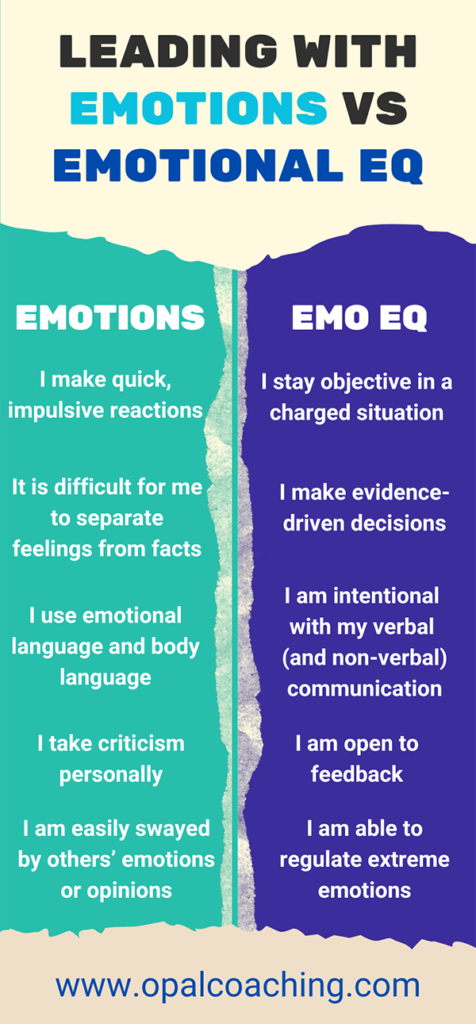Could your Emotions be Holding you Back?
5 Signs and 3 Tips to Improve Your Emotional Mastery

Emotions are contagious, especially when coming from a manager or leader. Learn to recognize if your Emotional EQ needs a boost, and three practical techniques to be seen as a stable and credible leader.
Todd is a developer rock star! He’s been a talented developer, and because of his strong performance, he was recently promoted to lead his team. He finds that moving up in his career is rewarding in many ways but has created many new challenges. Instead of having a clear focus as an individual contributor, his advancement means he is constantly balancing demands and expectations from others. As an introverted technical leader, Todd finds the context-switching exhausting. In addition, his performance is judged by how well he accomplishes collaborative goals, working with people who do not report to him. These new demands lead to a heightened emotional state, causing Todd to lead with his emotions. He finds himself getting upset quickly, overreacting to suggestions, and getting defensive. His performance feedback is getting more critical, and he knows it is time for a change.
If this resonates, read on. Like Todd, many new leaders find themselves grappling with heightened emotional states that can affect their performance and relationships. This article will guide you through actionable strategies to master emotional intelligence.
5 Signs your Emotional EQ needs a Boost
Recognizing these signs is the first step toward mastering your emotions and becoming a more effective leader.
- Quick, impulsive reactions: Reacting strongly to situations without taking time to process information or understand the full context.
- Overly emotional language: Using highly charged words or phrases that reflect your emotional state rather than objective facts.
- Difficulty separating feelings from facts: Struggling to distinguish between personal opinions and objective information when making decisions.
- Taking criticism personally: Becoming defensive or upset when receiving feedback, even if it’s constructive.
- Being easily swayed by others’ emotions: Changing your opinions or actions based on the emotions of people around you.
Managing emotions doesn’t mean that we need to suppress all emotions. The key to mastering your feelings is to use techniques and tactics to form the appropriate response for the situation, growing your emotional intelligence. Emotional intelligence is the awareness of how your thoughts, speech, and actions impact others. It has been described as the “unique intersection between head and heart.” Your Emotional EQ uses this awareness to self-manage your emotions and cognitive thought. It’s the factor that helps humans combine impulse control and social awareness to moderate behavior and relationships. High emotional intelligence also strengthens coping skills and resiliency.
If you find yourself reacting emotionally, focus instead on demonstrating these five behaviors:
- Stay Objective: Effective emotional management helps people stay calm and objective when dealing with conflicts, allowing them to mediate disputes fairly and constructively.
- Process your emotions elsewhere: When you know your emotions are taking charge and can channel them elsewhere, you can then express yourself without inflammatory language, and that includes non-verbal language, too.
- Evidence-driven Decisions: Leaders who manage their emotions make rational decisions based on facts rather than being influenced by personal biases, stress, or other people’s emotions.
- Open to feedback: People who actively listen and consider another person’s perspective without automatically assuming a threat or negativity build a culture that encourages innovation and collaboration.
- Perceived as stable and competent: A leader who can regulate their emotions creates a sense of stability and safety for others, leading to the perception of trustworthiness and competence.

Three Tips for Mastering Emotions
1. Stop Spreading the Mess
As I interact with new managers and emerging leaders, I often hear the same challenge pains: getting buffeted by their schedules like a boat in a storm. There’s no rhythm to their day; there’s no breathing room and, therefore, no thinking room. They often go from meeting to meeting and, most likely, bring the baggage from every previous interaction of the day to the next one. Coming into meetings loaded with pressure and anxiety affects not only their state of mind but also those around them.
Emotions are contagious. If you enter an interaction focused on all the tasks you are balancing, you will transmit your stress and anxiety to others. When people pick up on stress or worry, they stop focusing on things like innovation, problem-solving, and positive interactions with each other. Instead, practice preparing to attend your meetings relaxed, calm, and focused. One action to help with this is to reserve 15 minutes on your calendar before pivotal events to center yourself. Consider the energy you want to transmit as the leader during this time. Let previous interactions fade. The time you give yourself will reap rewards in presenting yourself as the leader you aspire to be.
Another practice is to process your emotions safely and productively. If you need to talk it out, use someone you trust to verbalize your emotions (and counter you if required). If a physical activity helps you clear your head, schedule that run or bike ride to process things.
After learning to stop spreading emotional baggage, the next step is to take control of the emotional climate you set.
2. Intentionally set the Emotional Temperature
As you prepare for a meaningful conversation or meeting, ask yourself what emotional climate would be the most productive for the job. Intentionally adjust the climate to the temperature best suited for the challenge at hand.
Are you about to deal with a problematic person? Be prepared with your facts and points so that the other person’s emotions will less impact what you need to say.
Are you going to introduce a new goal or item to work on? Set the stage with an optimistic vision and tone. If this isn’t a natural state for you, consider bringing in a partner to help convey the excitement of the new challenge.
A way to improve here is to ask yourself a few questions as you prepare for your next interaction, which helps you consider your audience and what they need versus what you need. You can start by using a few ‘How’ and ‘What’ questions.
- What are two things I can do to increase the interest in what I need so I can garner good collaboration?
- What are two things others want to know about the issue I will be discussing so they can ultimately create innovative solutions?
- How can I learn from others during this meeting?
3. Frame (and Reframe) the Message
Being constantly aware of how we impact others with language or facial expressions is impossible. We don’t get to see what others see. And it can be more challenging with remote work. If we are on camera, humans tend to watch ourselves instead of the others. Many people prefer to stay off-camera, making it even more difficult because we cannot tell what other’s nonverbal language is telling us.
Positive language, both verbal and non-verbal, can be transformational. However, our messaging must be authentic, and clarity of the message is just as important. It is essential not to send mixed messages.
One self-awareness technique is to ask others close to you if you tend to smile while delivering negative news. What does this tell the receiver of the message? How does this affect the perception of your authenticity over time?
Another practice is to write down three negative phrases you know you have said about clients, stakeholders, or the organization you work for. (We’ve all fallen victim to this!) Take your time and find three authentic ways to replace those phrases.
This behavior change may require stringent self-evaluation and accountability. As an accountability technique, ask a trusted colleague to support your commitment to growing your Emotional EQ by giving immediate feedback after an event. I’ve used this practice consistently in my coaching career to soften my delivery and become more aware of my language and tone of voice’s impact on others. My accountability partner helped me identify better ways to phrase things and bring attention to my body language, facial expressions, and body language. A feedback session directly after pivotal meetings helped me grow my awareness and change my behavior.
This behavior is challenging to break and will take time, attention, self-reflection, and accountability. Suppose you do not have a good option for an accountability partner.
Coaching is a powerful asset to help identify your self-knowledge and focus on positive change. Your organization may offer coaching, or you can easily find one through several coaching organizations.
If you find yourself slipping into negative behavior, remember that tomorrow is a new day. The good news is that you can learn to replace harmful language with positive, solution-oriented approaches. Reframing messages helps leaders build trust and authenticity.
In conclusion
The best leaders learn to manage their emotions and still come across as authentic. The biggest challenge about managing emotions in the moment is understanding and articulating to yourself: What emotion am I feeling? Why am I feeling it? How is it affecting others? What do I need to do to move through this?” When you create a self-awareness practice, your Emotional EQ grows over time, empowering you and fostering a safe and engaging culture. It’s a challenging journey that can help you stand out over time. Writing down your progress will validate the habits you are creating and the self-awareness you are building. Consider keeping a work journal to mark your progress over time and celebrate your wins. Working with a coach can be a powerful tool to help. If you’d like to learn if coaching is right for you, reach out for a free conversation at opalcoaching.com.
As you start to change, others may follow your lead. Your evolution may spark an opportunity to work with others to grow a safe and enriching environment that helps everyone thrive. I hope these tips will complement what you are already doing well and help you create an actionable plan to improve your emotional intelligence and the emotional climate in your team. You will find that focusing on how your behavior impacts others will change your relationships and positively impact your career.
If you find this article helpful, I want to learn what you plan to do differently. Please comment below.
~Julee Everett
Live your truth; hone your craft; show your thanks


